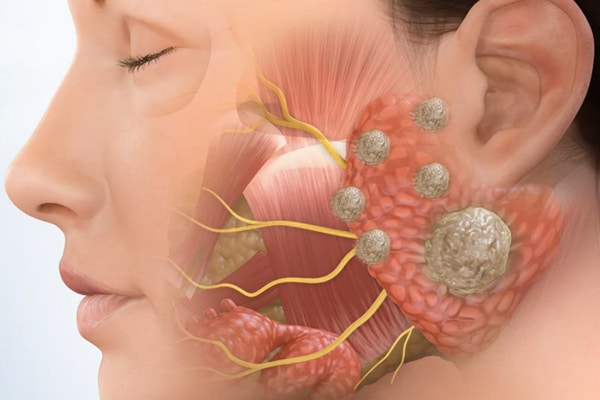Salivary gland tumors are growths of abnormal cells (tumors) that begin in the salivary glands. Salivary gland tumors are rare.



Salivary gland tumors are growths of abnormal cells (tumors) that begin in the salivary glands. Salivary gland tumors are rare.
Salivary gland tumors are abnormal cells growing in the gland or in the tubes (ducts) that drain the salivary glands.
The salivary glands are located around the mouth. They produce saliva, which moistens food to help with chewing and swallowing. Saliva also helps to protect teeth from decay.
There are 3 main pairs of salivary glands. The parotid glands are the largest. They are located in each cheek in front of the ears. Two submandibular glands are under the floor of the mouth under both sides of the jaw. Two sublingual glands are under the floor of the mouth. There are also hundreds of small salivary glands lining the rest of the mouth. These are called the minor salivary glands.
Salivary glands empty saliva into the mouth through ducts that open at various places in the mouth.
Salivary gland tumors are rare. Swelling of the salivary glands is mostly due to:
The most common type of salivary gland tumor is a slow-growing noncancerous (benign) tumor of the parotid gland. The tumor gradually increases the size of the gland. Some of these tumors can be cancerous (malignant).
There are many types of salivary gland cancers, named according to the type of cell they resemble. They include:
The most common type of salivary gland cancer. It often starts in the parotid glands but can develop in others.
Adenoid cystic carcinoma is a rare form of adenocarcinoma, which is a type of cancer that can exist in many different body sites. It most often occurs in the areas of the head and neck — in particular the salivary glands. Adenoid cystic carcinoma has also been reported in the breast, lacrimal gland of the eye, lung, brain, bartholin gland, and trachea.
Many types of salivary gland adenocarcinomas, including acinic cell carcinoma, polymorphous low-grade adenocarcinoma (PLGA), and others, some very rare.
A risk factor is anything that may increase a person's chance of developing a disease. It may be an activity--such as smoking or diet, family history, or many other things. Different diseases, including cancers, have different risk factors.
Although these factors can increase a person's risk, they do not necessarily cause the disease. Some people with one or more risk factors never develop the disease, while others develop disease and have no known risk factors. But, knowing your risk factors to any disease can help to guide you into the appropriate actions, including changing behaviors and being clinically monitored for the disease.

Some studies have suggested an association between high use of mobile phones and an increased risk of benign and malignant parotid tumours. However, others have found no evidence of such a relationship.
Radiation to the neck increases the risk of malignancy of salivary glands with a 15- to 20-year latency.
Use bimanual palpation of the lateral pharyngeal wall for deep lobe parotid tumours and the extent of submandibular and sublingual masses.
Clinical features of a salivary gland mass suggestive of malignancy are :
Most salivary gland neoplasms are a slowly enlarging painless mass:
Facial palsy with a salivary gland mass indicates malignancy.
Pain can occur with both benign and malignant tumours. Pain may arise from suppuration or haemorrhage into a mass or from infiltration of adjacent tissue.
In addition to a complete medical history and physical examination, diagnostic procedures for salivary gland cancer may include one or more of the following :
A noninvasive procedure that takes horizontal, or axial, images of the brain or other internal organs to detect any abnormalities that may not show up on an ordinary X-ray.
A diagnostic imaging technique that uses high-frequency sound waves to create an image of the internal organs.
A noninvasive procedure that produces 2-dimensional view of an internal organ or structure, especially the brain and spinal cord. If additional imaging is needed, your doctor may order a PET scan, which can determine where your cancer started.
A procedure to find malignant tumor cells in the body. A small amount of radioactive glucose (sugar) is injected into a vein. The PET scanner rotates around the body and makes a picture of where glucose is being used in the body. Malignant tumor cells show up brighter in the picture because they are more active and take up more glucose than normal cells do.
An endoscope is a thin, tube-like instrument with a light and a lens for viewing. An endoscopy procedure is used to look at organs and tissues inside the body to check for abnormal areas. For salivary gland cancer, an endoscope is inserted into the nose to look at the nose, throat, and larynx. The scope can also be used to obtain biopsies.
A procedure in which tissue samples are removed (with a needle or during surgery) from the body for examination under a microscope to determine if cancer or other abnormal cells are present.
Fine needle aspiration (FNA) biopsy: The removal of tissue or fluid using a thin needle. An FNA is the most common type of biopsy used for salivary gland cancer.
Incisional biopsy: The removal of part of a lump or a sample of tissue that doesn’t look normal.
Surgery: If cancer cannot be diagnosed from the sample of tissue removed during an FNA biopsy or an incisional biopsy, the mass may be removed and checked for signs of cancer.
Because salivary gland cancer can be hard to diagnose, patients should ask to have the tissue samples checked by a pathologist who has experience in diagnosing salivary gland cancer. Once a diagnosis is made, the cancer will be staged (to determine the extent of the disease) before a treatment plan is established.
The salivary glands help in eating and digesting food, patients may need special help adjusting to the side effects of the cancer and its treatment. You may be referred to other healthcare specialists who have experience and expertise in treating patients with salivary gland cancer and who specialize in certain areas of health care. These include the following:
Treatment may include :
A surgeon may remove the cancer and some of the healthy tissue around the cancer. Adjacent lymph nodes may also be removed with surgery.
Primary tumor resection Removal of the entire tumor and surrounding area of tissue
Transoral Robotic Surgery (TORS) A minimally invasive procedure which improves outcomes and avoids complications may be used for minor salivary gland cancers in the pharynx or throat.
Treatment that uses high-energy rays that kill cancer cells and halts the spread of cancer. Radiation therapy is very localized, aimed at the cancer area. Radiation therapy may be administered externally with a machine, or internally with radioactive materials.
Medications that go throughout the entire body to kill cancer cells. Chemotherapy has the ability to interfere with the cancer cell's replication. Chemotherapy may be used in combination with surgery and radiation therapy.
Drugs that target specific cancer cells and immune mechanisms are also an option and often cause fewer side effects than chemotherapy that kills both cancerous and noncancerous cells.